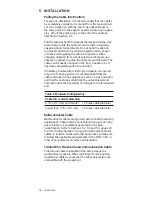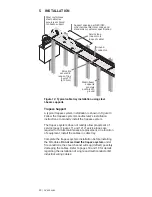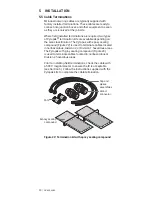
Connect the MI cable to junction boxes, motors, or other
equipment suitable for the area classification (hazardous
or nonhazardous) and environmental conditions
(corrosive, wet, etc.) expected. Metal junction boxes are
recommended because the cable sheath can be bonded to
ground, through the gland connector, to the junction box.
If using nonmetallic junction boxes, the gland connector
must be connected to a ground bushing (Figure 14) to
ensure that the cable sheath is bonded to ground.
Figure 14: Typical ground bushing (for nonmetallic
enclosures only)
Install the “pot” so that it extends above the bottom of the
junction box (Figures 15 and 16) to prevent moisture, due
to condensation, from contaminating the face of the pot.
Screw the gland connector into the junction box hub and
tighten the compression nut (rear nut on gland connector)
to the torque value shown on the tag supplied with the
factory terminated cable or field termination kit. This
ensures that the cable sheath is properly bonded to ground
and provides a proper flame path in hazardous areas.
Note: Minimize handling the tails to avoid breakage.
5 INSTALLATION
24 | nVent.com
Summary of Contents for pyrotenax Alloy 825
Page 1: ...MI Cable Industrial Wiring Installation Manual For Alloy 825 Sheath Cables ...
Page 4: ...iv nVent com ...
Page 46: ...42 nVent com ...
Page 47: ...nVent com 43 ...
















































